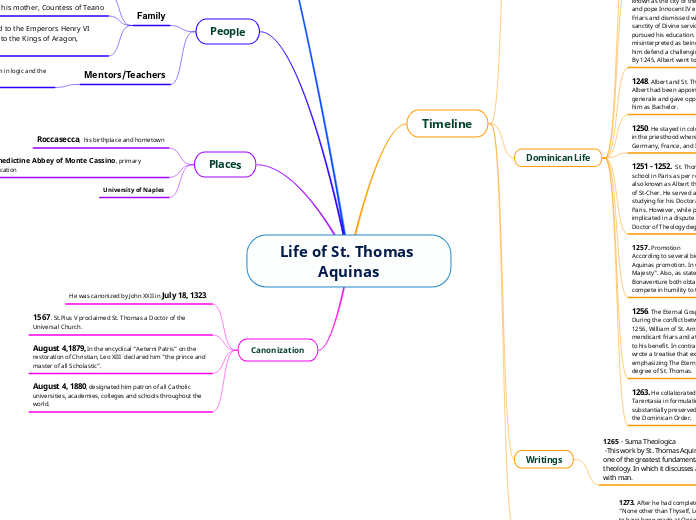
Early Life
Before his birth, someone told her mother—Teodora, that "He will enter the Order of Friars Preachers, and so great will be his learning and sanctity that in his day no one will be found to equal him".
1225. He was born in Roccaseca
1230. At the age of five, according to the custom of the times, he was sent to receive his first training from the Benedictine monks of Monte Cassino. Diligent in study, he was thus early noted as being meditative and devoted to prayer, and his preceptor was surprised at hearing the child ask frequently: "What is God?"
1236. He was sent to the University of Naples. The change was made at the instance of the Abbot of Monte Cassino, who wrote to Thomas's father that a boy of such talents should not be left in obscurity. He was then given over to Peter of Ireland. The youth's heart had remained pure amidst the corruption with which he was surrounded, and he resolved to embrace the religious life.
Dominican Life
1240. He received the habit of the order of St. Dominic. He was taken to Rome by the Dominicans because of the fear that his mother will take him away. And confined in the fortress of San Giovanni at Roccasecca.
1243. The time he spent in captivity was not lost. The Dominicans allowed to provide him new habits. After 2 years spent in prison, he was set at liberty into the arms of the Dominicans.
1244 - 1245. St. Thomas was sent into Rome which is also known as the city of the pope wherein he pronounced his vows and pope Innocent IV evaluated his purpose in joining the Friars and dismissed with a blessing which gave him the sanctity of Divine service. He was then sent to Paris where he pursued his education. His taciturn personality was misinterpreted as being uninterested, hence, upon hearing him defend a challenging thesis, Albert realized his potential. By 1245, Albert went to Paris with St. Thomas as a student.
1248. Albert and St. Thomas went back to the cologne wherein Albert had been appointed to teach at the new studium generale and gave opportunity to St. Thomas to teach under him as Bachelor.
1250. He stayed in cologne along with Conrad of Hochstaden in the priesthood where he preached the word of God in Germany, France, and Italy
1251 - 1252. St. Thomas was employed at a Dominican school in Paris as per recommendation by St. Albertus Magnus also known as Albert the Great, and St. Hugo S. Charo or Hugh of St-Cher. He served an obligatory teaching term there while studying for his Doctorate in Theology at the University of Paris. However, while pursuing his degree, his university was implicated in a dispute with friars, which negatively affected his Doctor of Theology degree.
1257. Promotion
According to several biographers, it was the day of St. Thomas Aquinas promotion. In which the subject of it was, "Christ Majesty". Also, as stated in the narrative, St. Thomas and St. Bonaventure both obtained their doctorates that day, and must compete in humility to tell who would be promoted first.
1256. The Eternal Gospel
During the conflict between the friars and the university in 1256, William of St. Amour became a leader of opposing mendicant friars and attacked St. Thomas and St. Bonaventure to his benefit. In contrast to William of St. Amour, St Thomas wrote a treatise that exposed the opposition while also emphasizing The Eternal Gospel that firmly retrieved the degree of St. Thomas.
1263. He collaborated with Albertues Magnus and Peter of Tarentasia in formulating the system of studies which is substantially preserved to this day in the studia generalia of the Dominican Order.
Writings
1265 - Suma Theologica
-This work by St. Thomas Aquinas was and continues to be one of the greatest fundamental books of Christian theology. In which it discusses about God's connection with man.
Latter Years
1273. After he had completed his treatise on the Eucharist. “None other than Thyself, Lord”.Similar declarations are said to have been made at Orvieto
He laid aside his pen and wrote no more; “ I can do no more. Such secrets have been revealed to me that all I have written now appears to be of little value.”
1274. Thomas began his preparation for his death; “This is my rest for ever and ever; here will I dwell, for I have chosen it”.
He died on March 7, 1274. Numerous miracles attested his sanctity
Family
Landulph, his father, the Count of Aquino
Theodora, his mother, Countess of Teano
His family was related to the Emperors Henry VI and Frederick II, and to the Kings of Aragon, Castile, and France.
Mentors/Teachers
Peter of Ireland, a lecturer that trained him in logic and the natural sciences.
Roccasecca, his birthplace and hometown
Benedictine Abbey of Monte Cassino, primary education
University of Naples
He was canonized by John XXII in July 18, 1323.
1567. St.Pius V proclaimed St. Thomas a Doctor of the Universal Church.
August 4,1879, In the encyclical “Aeterni Patris” on the restoration of Christian, Leo XIII declared him “the prince and master of all Scholastic”.
August 4, 1880, designated him patron of all Catholic universities, academies, colleges and schools throughout the world.